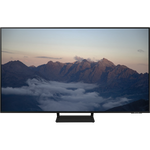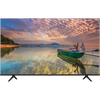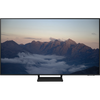A comparison of specs, key information, reviews, and best pricing from top retailers
Last updated -- hours ago | Report incorrect information
What we think

The PerfectRec TV team Learn more
Updated January 10, 2024·
If you're on a budget and want a cost-effective TV, the Hisense A6H may suit you. However, it doesn't perform well in bright rooms and is not the best for dark room viewing. On the other hand, if you can spend more and prioritize higher picture quality, particularly in bright environments, and a better experience for movies, sports, and gaming, the Samsung Q70A is a superior choice. Give Feedback
this description is based on the product variant with some specs and product variant with some specs. At the time of writing, the variant with some specs cost some dollars and the variant with some specs cost some dollars.
Advantages of the Hisense A6H (LCD)
- Good viewing angle
Advantages of the Samsung Q70A (LCD)
- Good for bright room
- Good for gaming
- Good for news, talk, & other TV
- Very good for cartoons & animation
- Good for use as monitor
- Very good motion processing
Key differences
Picture Quality
5.2


7.2
3.35/10
CONTRAST
8.21/10
6.1/10
COLOR VOLUME SCORE
7.0/10
LED
PANEL TYPE
LED
IPS
PANEL SUB-TYPE
VA
The Samsung Q70A (LCD) has good picture quality, while the Hisense A6H (LCD) has poor picture quality.
Movies & TV
4.9


6.4
3.35/10
CONTRAST
8.21/10
5.4/10
BLACK UNIFORMITY
6.8/10
7.5/10
UPSCALING
7.5/10
Yes
HDR10 SUPPORT
Yes
Yes
HDR10+ SUPPORT
Yes
Yes
DOLBY VISION SUPPORT
No
The Samsung Q70A (LCD) is only fair for movies & TV, while the Hisense A6H (LCD) is poor.
Sports
6.1


6.7
2.5/10
MOTION PROCESSING
8.0/10
60Hz
REFRESH RATE
120Hz
10.0/10
INPUT LAG SCORE
10.0/10
7.5/10
UPSCALING
7.5/10
5.5/10
SDR BRIGHTNESS SCORE
8.6/10
Yes
HLG SUPPORT
Yes
The Samsung Q70A (LCD) and Hisense A6H (LCD) are both only fair for sports, though the Samsung Q70A (LCD) is somewhat better.
The Hisense A6H has a better viewing angle, which is advantageous for watching sports with a group, but its motion processing is not specified and may be inferior, impacting fast-moving images. On the other hand, the Samsung Q70A has superior motion processing which enhances fast action scenes, but its reflections handling is poor, potentially reducing visibility in bright rooms.
Gaming
5.7


7.7
5.9/10
RESPONSE TIME SCORE
8.0/10
10.0/10
INPUT LAG SCORE
10.0/10
2.5/10
MOTION PROCESSING
8.0/10
0.0/100
GAMING LOCAL DIMMING
0.0/100
5.4/10
GAME HDR BRIGHTNESS SCORE
7.3/10
The Samsung Q70A (LCD) is good for gaming, while the Hisense A6H (LCD) is poor.
The Hisense A6H has a poor response time which can lead to motion blur during gaming, while the Samsung Q70A offers a very good response time, providing a clearer image during fast-paced games. Both TVs have the best input lag performance; however, the better response time on the Samsung Q70A makes it more suitable for gaming.
Cartoons & Animation
5.7


8.2
5.9/10
COLOR GAMUT SCORE
7.1/10
6.1/10
COLOR VOLUME SCORE
7.0/10
5.5/10
SDR BRIGHTNESS SCORE
8.6/10
8.3/10
COLORS OUT OF THE BOX SCORE
8.5/10
7.7/10
GRAY UNIFORMITY
6.0/10
The Samsung Q70A (LCD) is very good for cartoons & animation, while the Hisense A6H (LCD) is poor.
The Hisense A6H displays colors poorly out of the box which affects the vividness and accuracy needed for animations, while the Samsung Q70A provides a much better color gamut and color volume, ensuring richer and more consistent colors across various shades, crucial for the vibrant visuals typical in cartoons.
News, Talk, & Other TV
5.8


7.6
5.5/10
SDR BRIGHTNESS SCORE
8.6/10
7.5/10
UPSCALING
7.5/10
The Samsung Q70A (LCD) is good for news, talk, & other TV, while the Hisense A6H (LCD) is poor.
The Hisense A6H has lower SDR brightness and weak colors out of the box, making it less ideal for watching news and other TV programs, especially in bright rooms. In contrast, the Samsung Q70A offers superior SDR brightness and better colors out of the box, providing clearer and more vivid images for such content.
Bright Room
5.4


7.4
7.8/10
VIEWING ANGLE
5.3/10
5.5/10
SDR BRIGHTNESS SCORE
8.6/10
5.3/10
HDR BRIGHTNESS SCORE
7.2/10
6.0/10
REFLECTIONS SCORE
5.9/10
The Samsung Q70A (LCD) is good for bright room, while the Hisense A6H (LCD) is poor.
The Hisense A6H struggles in bright rooms due to its lower brightness in both SDR and HDR content, and only fair performance in handling reflections, while the Samsung Q70A fares much better with good SDR and HDR brightness and poor reflection handling, implying it's less affected by ambient light. The Samsung also boasts better contrast and color volume, further enhancing its suitability for well-lit environments.
Cost
$650


$948
$200
$400
$600
$800
$1,000
$1,200
$1,400
The Hisense A6H (LCD) has a price of $650 and the Samsung Q70A (LCD) costs $948.

Let Us Help Find Your Perfect TV
Find your new TV
Give feedback
We’re constantly working to improve.
How the Hisense A6H (LCD) and the Samsung Q70A (LCD) compare to other TVs
Spec Comparison
| Hisense A6H (LCD) | Samsung Q70A (LCD) |
GENERAL | |||
|---|---|---|---|
| Price | |||
$650 | $948 | ||
Brand | |||
Brand | Hisense | Samsung | |
Release Date | |||
Release Date | April 3, 2022 | March 2, 2021 | |
Full name | |||
Full name | 65A6H | QN65Q70A | |
Screen Size | |||
Screen Size | 65" | 65" | |
Screen Resolution | |||
Screen Resolution | 4K | 4K | |
TV FEATURES | |||
|---|---|---|---|
Operating System | |||
Operating System | Google TV | Tizen | |
Sound Quality Score | |||
Sound Quality Score | 6.1/10 | 5.7/10 | |
NextGen Ready | |||
NextGen Ready | No | No | |
HDMI Ports | |||
HDMI Ports | 4 | 4 | |
Coax Ports | |||
Coax Ports | 1 | 1 | |
DISPLAY QUALITY SCORES | |||
|---|---|---|---|
Picture Quality Score | |||
Picture Quality Score | 5.3/10 | 7.2/10 | |
Bright Room Score | |||
Bright Room Score | 5.4/10 | 7.4/10 | |
Gaming Score | |||
Gaming Score | 5.8/10 | 7.8/10 | |
Movies & TV Score | |||
Movies & TV Score | 5/10 | 6.4/10 | |
Sports Score | |||
Sports Score | 6.1/10 | 6.7/10 | |
PHYSICAL | |||
|---|---|---|---|
Dimensions w/o Stand (H x W x D) | |||
Dimensions w/o Stand (H x W x D) | 32.8" x 57.2" x 2.9" | 32.8" x 57.2" x 1" | |
Dimensions with Stand (H x W) | |||
Dimensions with Stand (H x W) | 35.3" x 57.2" | 35.3" x 57.2" | |
Weight without Stand | |||
Weight without Stand | 36.4 lbs | 46.1 lbs | |
VESA Mount | |||
VESA Mount | 400 x 300 | 400 X 300 | |
DISPLAY | |||
|---|---|---|---|
Color Depth | |||
Color Depth | 10 bit | 10 bit | |
Black Frame Insertion | |||
Black Frame Insertion | No | Yes | |
Auto Low Latency Mode | |||
Auto Low Latency Mode | Yes | Yes | |
Contrast | |||
Contrast | 3.4/10 | 8.2/10 | |
Local Dimming | |||
Local Dimming | 2.5/10 | 2.5/10 | |
SOUND | |||
|---|---|---|---|
Speaker Setup | |||
Speaker Setup | 2.0 | 2.0 | |
Speaker Power | |||
Speaker Power | 28 W | 20 W | |
Dolby Atmos | |||
Dolby Atmos | Yes | Bypass only | |
DTS:X | |||
DTS:X | Yes | No | |
Get a great deal on the Hisense A6H (LCD) or the Samsung Q70A (LCD)
About Hisense
Hisense, a Chinese TV manufacturer, entered the US market in approximately 2011 and has since acquired TV divisions from various companies such as Toshiba, Sharp, Hitachi, and NEC. Currently ranking as the fourth largest vendor in terms of sales volume, Hisense aims to capture a wide range of TV budget segments. They offer exceptional value with TVs that often outperform their competitors at similar price points, making them a compelling choice for consumers. In the US, they use Google TV as their smart TV software which provides the largest app selection and a very modern user interface, however it is not as user friendly as the software from other vendors.
About Samsung
Samsung, a South Korean electronics manufacturer, holds the title of being the largest global TV vendor in terms of units sold. They offer a diverse lineup of TV products that cater to various budget ranges. A notable achievement in recent years is the development of Quantum Dots, a technology that enhances color reproduction, resulting in richer and more vibrant hues. Samsung TVs are well-regarded for their high manufacturing quality and user-friendly software, making them an excellent choice for consumers seeking an intuitive viewing experience.
Give feedback
We're constantly perfecting our model
TV guides you might be interested in
More comparisons for you
FAQs
FAQs about TVs
Why trust us
This information was produced and vetted by the PerfectRec TVs team. We are a product research and recommendation organization that meticulously reviews and evaluates the latest TV information and makes it digestible for you.
By the numbers
385
TVs evaluated
33,110
TVs stats compiled
21
Proprietary TVs ratings developed
121,830
Recommendations made
18,275
Consumer hours saved
About the TV team
Joe Golden, Ph.D
CEO and TVs Editor
Joe is an entrepreneur and lifelong electronics enthusiast with a Ph.D in Economics from the University of Michigan.
Jason Lew
Staff Expert & Software Engineer
Jason is a staff expert and software engineer that has been making laptop recommendations for 7 years and moderates one of the largest laptop subreddits.
Chandradeep Chowdhury
Staff Expert & Software Engineer
Chandradeep is a staff expert and software engineer and expert in televisions and monitors. He’s been making monitor recommendations for ten years.
Jaime Roldán
TVs Expert
Jaime is a Colombia-based TV expert. He is an electronics engineer with 8 years of experience in the telecom sector and has been making TV recommendations for 12 years.







